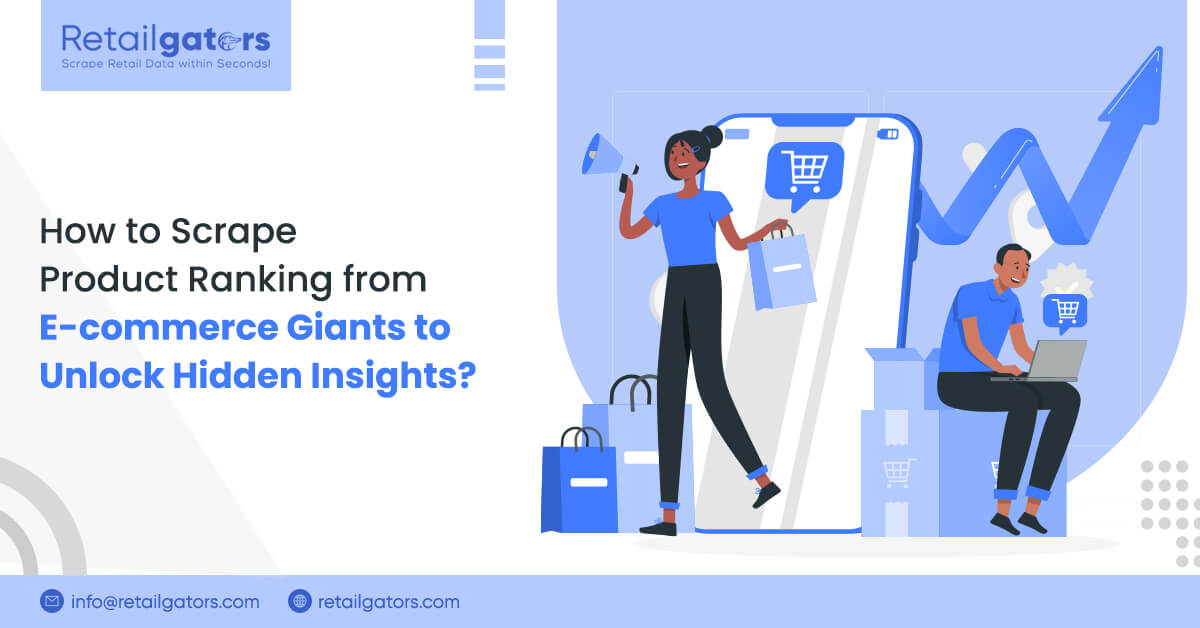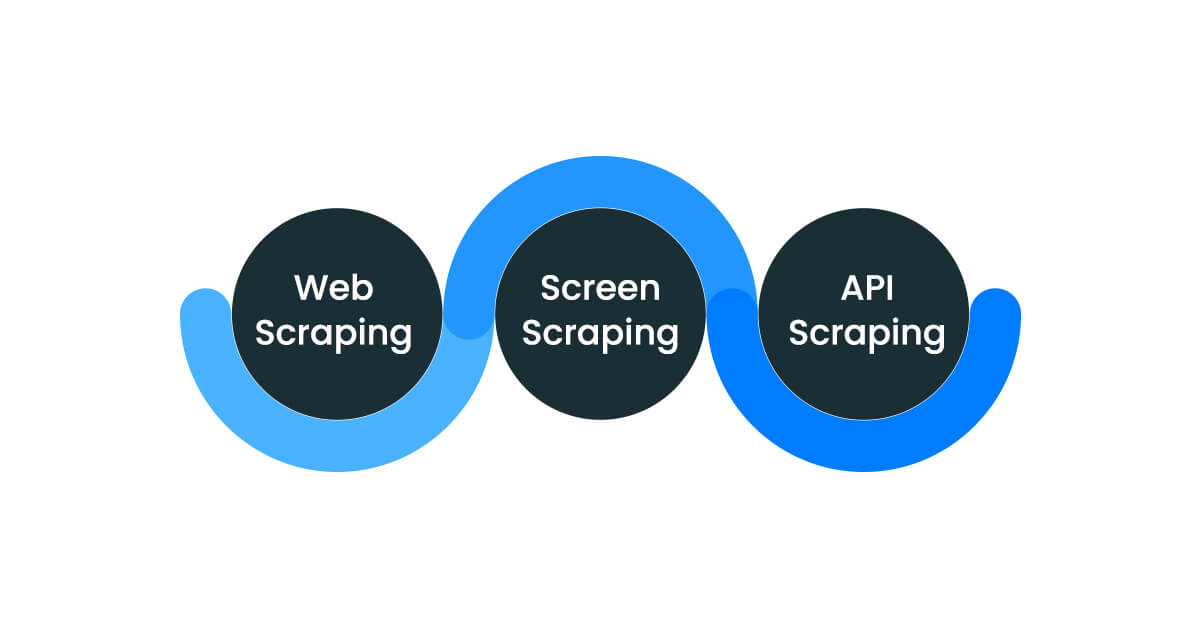
It is well known that the e-commerce realm is thriving, with giants like Amazon and Flipkart and up-and-coming platforms such as Blinkit and BigBasket making their place in the retail landscape. As businesses and sellers strive to master these marketplaces, decoding product rankings may seem like searching for a proverbial needle in a haystack. But how does one keep an eye on shifting product ranking across multiple e-commerce platforms? That's where product data scraping enters the scenario, providing critical knowledge to bolster your sales tactics. This blog helps you navigate the process of scraping product rankings on Amazon, Flipkart, Blinkit, and BigBasket.
What is Product Ranking in e-commerce data scraping?
In eCommerce data scraping, product ranking refers to the position of the product in the search result list, defined by the platform's algorithm. E-commerce platforms like Amazon, Flipkart, BigBasket, and Blinkit comprise millions of products; who decides which product should appear first?
Product rankings often change due to the number of people searching for a product, how well it's selling, and its reviews. They can also change based on how each platform's system ranks things, considering everything from price and customer ratings to how well the seller is doing and how users behave on the platform. Scraping tools can help determine where a product stands in the search results according to specific words people search for or categories. This data can be analyzed to see patterns, what competitors are doing, and what customers like. Looking at the data this way can point to which products are hot, which words work best in searches, and how shopper trends are shifting. You can use this information to learn more about the market, improve your products, and make informed business decisions.
Significance of Product Ranking and Data Scraping
The good things about knowing product rankings and e-commerce data scraping don't just stop at having an advantage over competition. It offers deep and wide-ranging insights for different people involved in the business.
For Businesses
Amazon data scraping platforms assists in market research by identifying trending products in a particular niche. You can take a cue from what your rivals are doing well, looking at the words they use to attract shoppers, how many clicks they get, and how many of these clicks turn into sales. This info can guide you in making ads and creating your items. Data lets you see how your rivals price their items so you can price yours right and keep earning. You can also find out which items are popular with customers and guess how much to stock so you don't have too many or too few. Plus, by looking at how shoppers interact with the web, you can make precise offers and recommend other items they'd like based on their shopping habits.
For Customers
Amazon Data Scraping empowers us by providing impartial insights about product rankings, reviews, and price comparisons, fostering more educated purchasing decisions. It uncovers less popular but highly ranked products due to their quality or user experience, which are yet to gain widespread recognition. With real-time product rankings and genuine reviews, your decisions can be based on trustworthy data, not just persuasive advertisements. You can monitor price changes and compare across various platforms to secure the most favorable deals and prevent overpayment. While personalization is helpful, fair product data scraping can give suggestions based on broader trends and your long search history, helping you find exciting new stuff you didn't know about.
Scraping Methods for Different Platforms

It is essential to get used to the unique features of each platform to scrape ethically. For example, use Beautiful Soup to break down HTML, Selenium for changing parts, and APIs for allowed access. Amazon and Flipkart are vast e-commerce platforms with millions of active users and billions of products available worldwide. BigBasket and Blinkit are e-commerce platforms with dynamic and real-time product updates. Amazon Data Scraping offers large volumes of data about which provides a strategic approach to navigating the enormous volumes of product data available.
Web Scraping
Python is commonly used to scrape product data due to its simplicity and extensive libraries. Data extraction often relies on Python libraries like Beautiful Soup and Selenium.
Beautiful Soup helps interpret HTML, making dealing with raw HTML tags less troublesome. It's beneficial when you need to understand the HTML layout of a product ranking page. Selenium is beneficial for handling content that's dynamically loaded via JavaScript. Certain aspects of product pages only appear following specific actions by the user, such as hovering, clicking, or scrolling. To scrape product data and rankings, you need to be familiar with the structure of products. You must examine and comprehend the HTML tags housing the necessary data, like the product name, rating, amount of ratings, and price.
Screen Scraping
Screen scraping can refer to capturing bitmap data from the screen and OCR (Optical Character Recognition) technology to capture data. However, the method is slightly different and significantly more efficient to scrape product data.
If you want to gather product rankings from an online store, pick your e-commerce platform. You'll then need to go to the website address (URL) of the specific page you're interested in. Once you're there, the page's content must be translated into a simpler, more accessible format. Your internet browser has helpers, like Chrome's "Inspect Elements", that help you find where the product ranking data is stored in that simpler format. The information is spread out across different pages. Thankfully, a good web scraping tool will savvily flip through all these like a digital book, collecting all the necessary info.
API Scraping
API (Application Programming Interface) scraping is an effective method for extracting product ranking data from e-commerce websites and is considered respectful towards server resources. Most modern e-commerce websites offer well-structured APIs, making extracting data more accessible and more efficient than typical scraping methods.
First, check if the online store you're interested in has an open API and understand its rules from its guide. Then, to get the data you need, use HTTP requests, often via a language such as Python. This process typically needs an API Key, which acts like a password to the site's server. The data you retrieve from the API will usually be in JSON or XML form. From this, you can extract product ranking details. As the data might span multiple 'pages', modifying your script to cycle through these pages is essential.
Product Ranking Insights from E-commerce Data Scraping
Scrape product data from e-commerce platforms like Amazon, Flipkart, BigBasket, and Blinkit to gain valuable insights into customers' preferences in their respective industries. Monitoring the rankings of competitor products can also show their product performance and the success of their marketing campaigns.
Product ranking essentially works as a performance metric. If your ranking is increasing, it suggests that your marketing strategies are working and customers are responding positively. But it's time to check for potential issues by analyzing customer feedback if it goes down. Product pricing can also have an impact on its rankings. It's crucial to balance attractive, competitive pricing and a high product ranking, as this is crucial for visibility and sales on the platform.
Products that rank high on search results tend to be more visible and sell more. If you keep a record of product ranking data, this can help when it comes to predicting future sales and making decisions about production and marketing efforts.
Ethical Considerations
While web scraping can provide valuable data on product rankings from e-commerce platforms like Amazon, it's important to follow ethical guidelines to respect the website, its data, and user privacy. Below are some ethical considerations to keep in mind:
- Review the target platform's terms of service to understand their policies on product data scraping. Some websites, including Amazon, forbid scraping and require you to use an API, if available.
- A site's robots.txt file provides information about what parts of the website can be crawled and/or scraped. Always respect the guidelines specified in this file.
- Make your requests at a reasonable rate to avoid overloading the website's server. Excessive requests in a short period can negatively affect a site's performance for other users and may even cause it to crash.
- Remember to include a user agent and headers to identify your scraper when making requests. Being transparent about your intentions showcases responsible scraping behaviour.
- Practice responsible data management by encrypting and securely storing any collected data and restricting access to authorized users only.
Conclusion
In conclusion, scraping product rankings from e-commerce giants like Amazon, Flipkart, Blinkit, and BigBasket provides lots of information. This information comes from billions of pieces of data and helps businesses get a good view of the market. Whether it's helping boost search rankings, getting pricing right, or knowing what customers want, the benefits are big and wide-ranging. This data can help businesses fine-tune their strategies to edge over competitors. Retailgators is a reliable retail data scraper that provides accessible and actionable e-commerce data to help businesses. We provide real-time data from dynamic sites like Amazon, Flipkart, BigBasket and Blinkit. You concentrate on your product ranking and leave the product data scraping to us.








Leave a Reply
Your email address will not be published. Required fields are marked